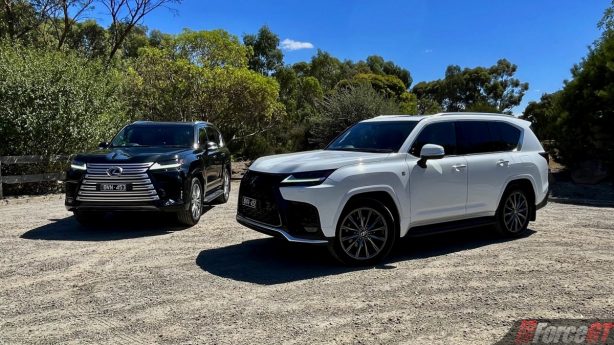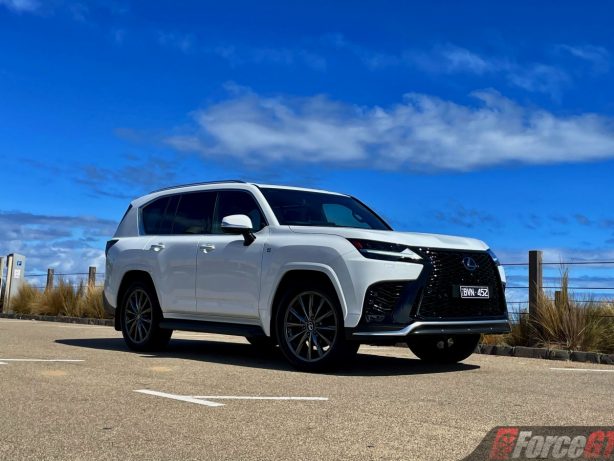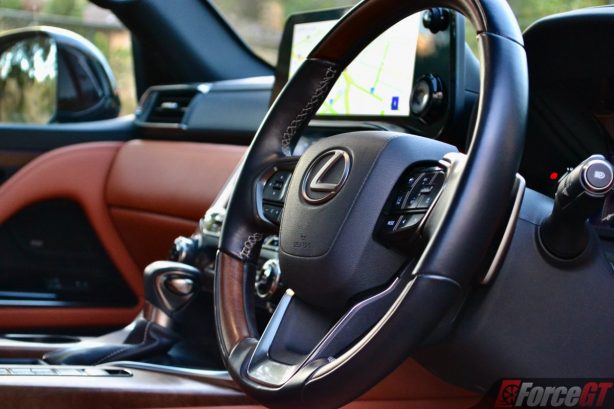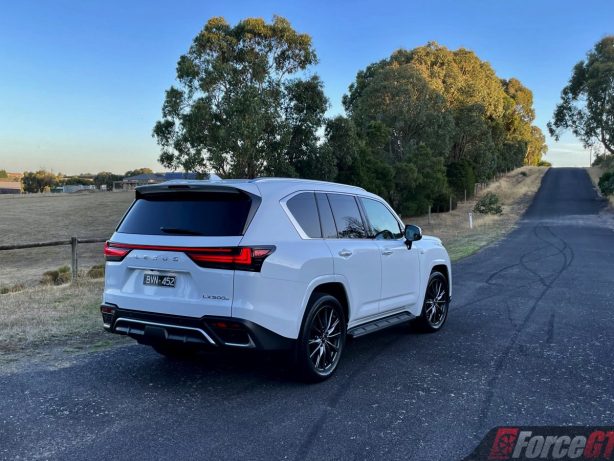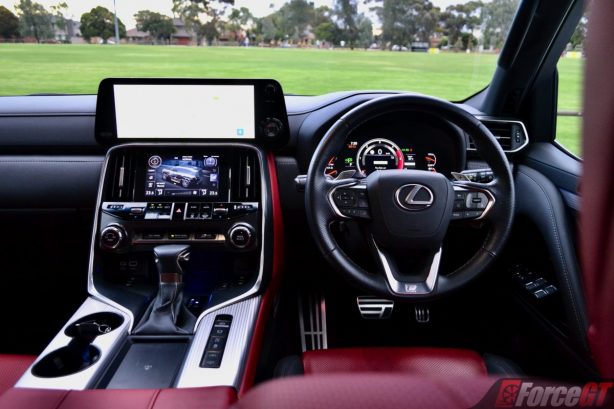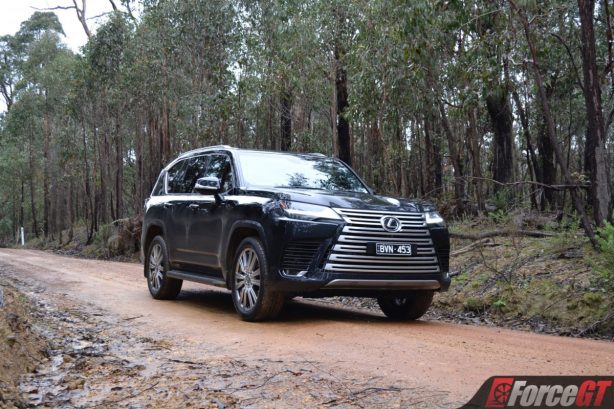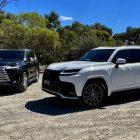The latest fourth-generation Lexus LX represents one significant shift from previous models and that’s in the use of downsized six-cylinder engines across all variants rather than eight-cylinder units.
We have already covered all main aspects of the LX in our previous in-depth review, which you can read here. In this review we explore and compare the new crop of petrol and diesel V6s powering the new LX and see if the smaller engines are a good fill for the brilliant V8s from previous generations of LX.
The new LX range now spans five variants with seven-, five- and four-seat configurations available, the latter offered for the first time. The seven-seat LX kicks off the line-up, with the option to up-spec available through an Enhancement Pack. Five-seat models consist of the Sports Luxury and F Sport. The newly introduced Ultra Luxury model is the new range-topper, offering a first-class-like four-seater cabin.
All models are available with either petrol or diesel power, except for the Ultra Luxury which is strictly petrol only. For this review, we tested the diesel LX 500d F Sport and petrol LX 600 Ultra Luxury.
The Lexus LX pricing is as follows (prices exclude on-road costs):
LX 500d | LX 600 | |
Seven-seat | $148,800 | $152,300 |
With Enhancement Pack | $154,300 | $157,800 |
Sports Luxury (5-seat) | $165,800 | $169,300 |
F Sport (5-seat) | $171,800 | $175,300 |
Ultra Luxury (4-seat) | – | $210,800 |
Petrol powered models cost $3,500 more than their respective diesel equivalent. With that you get a 3.5-litre twin-turbo V6 petrol engine that develops 305kW of power at 5200rpm and 650Nm of torque between 2000rpm and 3600rpm. It’s an increase of 35kW and 120Nm over the previous 5.7-litre normally aspirated V8 which produced 270kW and 530Nm.
The V6 petrol is the same engine as that found in the LS 500, albeit tuned slightly differently. As with the flagship saloon, this engine is one of the most refined turbo V6s we have sampled. So, the question of whether we miss the old V8 petrol can be answered with a resounding no because the V6 is just as smooth, if not smoother than the old V8.
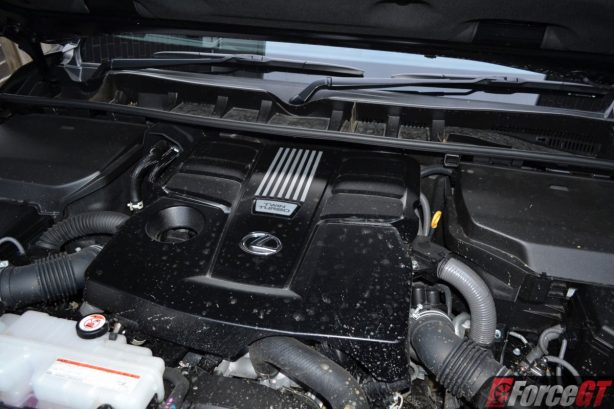
It’s not just the refinement that is impressive, as the power delivery is just as linear as the previous V8. That’s a big score because the V6 is forced-fed and the lack of lag is most welcomed. There’s a distinct liveliness to the throttle response that’s not like the typical turbo engines.
With the onslaught of 650Nm of torque from low in the rev range, there isn’t a moment of struggle hauling the 2.6 tonne SUV around, even with a full load. That can’t be said with the previous V8 where its peak torque of 530Nm doesn’t arrive until 3200rpm.
The ten-speed automatic transmission that’s paired with the V6 petrol (and V6 diesel) may seem like two ratios too many, but the last three ratios are overdrive ratios and there to aid fuel economy. If you’re used to the close ratios in European eight-speed autos, you’ll need to get used to the longer lower ratios in the LX’ Aisin unit. It pulls a little longer in those lower gears, which is great for city driving as there’s less frequent gear changes. Getting up to speed, the ratios are more closely stacked, keeping revs low and maximising the chubby midrange torque.
Rated fuel economy for the petrol V6 is 12.1L/100km for the combined average. It’s certainly not the thriftiest of engines. For much better fuel efficiency, the diesel LX is the pick and that’s what we’re taking a closer look next.
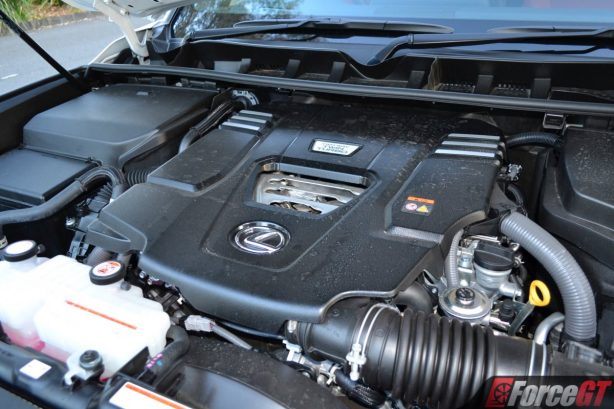
A newer engine than the turbo petrol V6, the all-new 3.3-litre twin-turbo diesel V6 engine makes first application in the current LX and Toyota LandCruiser. It boasts 227kW of power at 4000rpm and 700Nm of torque from 1600rpm to 2600rpm, a hike of 27kW and 50Nm compared with the previous 4.5-litre V8 turbo-diesel engine. Those are some impressive figures considering the drop of two cylinders from the old V8 to the new V6.
Against the V6 petrol, the diesel has a power deficit of 78kW but 50Nm more torque. The latter makes all the difference in the driving experience, not so much with the extra 50Nm but more the case of that peak torque arriving at just 1600rpm. It translates to a solid and persevering grunt that pulls the LX effortlessly right from the get go. Be it full load, uphill or towing, there’s no stopping the V6 diesel and its mighty pull.
It’s also one of the smoothest and quietest diesel power plants out there. In fact, from inside the LX it’s difficult to sniff out the oil burner lurking discretely under the bonnet. It does sing a different tune to the V6 petrol, harder and more mechanical sounding, but other than that it’s just as refined as the petrol unit.
As expected, the diesel’s throttle response is less lively than the petrol’s and its lazier demeanour means it doesn’t rev as hard. Both characteristics evident in the sprint from standstill to 100km/h, where the V6 petrol is a full second quicker at 7.0 seconds compared to the V6 diesel’s 8.0 seconds.
The V6 diesel is also matched to the same ten-speed auto as that used for the V6 petrol. It uses the same ratios as well, but because the diesel revs lower than the petrol the long ratios in the lower gears don’t feel as long. This delivers a more relaxing driving experience.
The V6 diesel is hands down the cheaper engine to run. Its combined average fuel economy figure of 8.9L/100km is over 3L more frugal per 100km compared to the V6 petrol. In urban driving the difference in fuel economy is huge, with the diesel rated at 11.3L/100km against the petrol’s 16.7L/100km. In the real world with over 500km travelled on each petrol and diesel powered LX, we recorded an average of 13.4L/100km for the petrol and 11.5L/100km for the diesel.
We did some soft off-roading in both petrol and diesel LX variants and found that both versions are equally capable on the rough stuff. That said, the diesel is the better mill if there’s towing involved. It’s worth noting that the LX 500d F Sport we drove is fitted as standard with a rear Torsen limited-slip differential which non-F Sport models don’t have. It distributes drive between the left and right rear wheels in response to throttle position and terrain conditions. While we didn’t notice much of a difference between the LX 500d F Sport and LX 600 Ultra Luxury during our mild off-road excursion, more hardcore off-roading should benefit from the added traction afforded by the active rear diff in the F Sport.
Verdict
V8-powered Lexus LXs have become a thing of the past, but the new more powerful, more efficient turbo V6s are so good that they completely overshadow the old V8s. Choosing between the V6 petrol and V6 diesel is a dilemma though. There’s very little in between them in terms of refinement and performance. The V6 petrol is slightly more lively and eager, which would pair well with the F Sport trimmed LX, while the V6 diesel is a better workhorse and much more fuel economical which would suit the Sports Luxury grade. Both deliver their own unique driving flavour, but are more than up to the task in a full-size SUV like the LX.
| 2024 Lexus LX 500d 3.3L Twin-Turbo V6 Diesel | 2024 Lexus LX 600 3.5L Twin-Turbo V6 Petrol | |
| Refinement | 8.0 | 8.5 |
| Responsiveness | 8.0 | 8.5 |
| Performance | 8.5 | 8.5 |
| Towing Ability | 8.0 | 7.0 |
| Efficiency | 8.0 | 7.0 |
| Overall | 41/50 | 40/50 |
2024 Lexus LX pricing and specifications
| Price (excluding on-road costs): | From: $148,800 LX 500d F Sport as tested: $171,800 LX 600 Ultra Luxury as tested: $210,800 |
| Warranty: | 5 years/unlimited kilometre |
| Warranty Customer Assistance: | 5 years roadside |
| Service Intervals: | 6 months/10,000km |
| Country of Origin: | Japan |
| Engine: | LX500d 3.3-litre twin-turbocharged common rail direct injection V6 diesel: 227kW @ 4,000rpm, 700Nm @ 1,600-2,600rpm LX600 3.5-litre twin-turbocharged intercooled, direct injection V6 petrol: 305kW @ 5,200rpm, 650Nm @ 2,000-3,600rpm |
| Transmission: | 10-speed automatic |
| Drivetrain: | Four-wheel drive, dual-range |
| Power-to-Weight Ratio (W/kg): | LX500d: 87.3 LX600:118.0 |
| 0-100km/h (seconds): | LX500d: Claimed: 8.0 LX600: 7.0 |
| Combined Fuel Consumption (L/100km): | LX500d: Claimed: 8.9/Tested: 11.5 LX600: Claimed: 12.1/Tested: 13.4 |
| RON Rating: | Diesel, 95 |
| Fuel Capacity (L): | 110 |
| Body: | 5-door SUV, 5 seats |
| Safety: | ANCAP not rated, 10 airbags, ABS, EBD, BA, VSC, Pre-Collision Safety System with Pre-Collision Braking, Lane Departure Warning, Blind Spot Monitoring, Rear Cross Traffic Alert, Trailer Sway Control, Adaptive High-Beam, Tyre Pressure Monitoring System, 360-degree camera, ISOFIX |
| Dimensions (L/W/H/W-B): | 5,090/1,990/1,895/2,850 |
| Boot Space (min/max) (L): | LX500d: 1,109/1,960 LX600: 767 (max) |
| Turning Circle Between Kerbs: | 12.8 |
| Ground Clearance: | 205 |
| Wading Depth: | N/a |
| Approach Angle: | 22 |
| Departure Angle: | 22.8 |
| Breakover Angle: | 22.7 |
| Kerb Weight (kg): | LX500d: 2,685 LX600: 2,660 |
| Towing Capacity (kg): | Braked: 3,500/Unbraked: 750 |
| Entertainment: | 12.3-inch colour touchscreen with “Hey Lexus” voice control, satellite navigation, AM/FM/DAB+, Bluetooth, USB, AUX, CD/DVD, iPod, 25-speaker Mark Levinson Sound System 11.6-inch rear seat entertainment system |
 ForceGT.com Car News, Car Reviews, Video Reviews, Tuning and much more.
ForceGT.com Car News, Car Reviews, Video Reviews, Tuning and much more. 